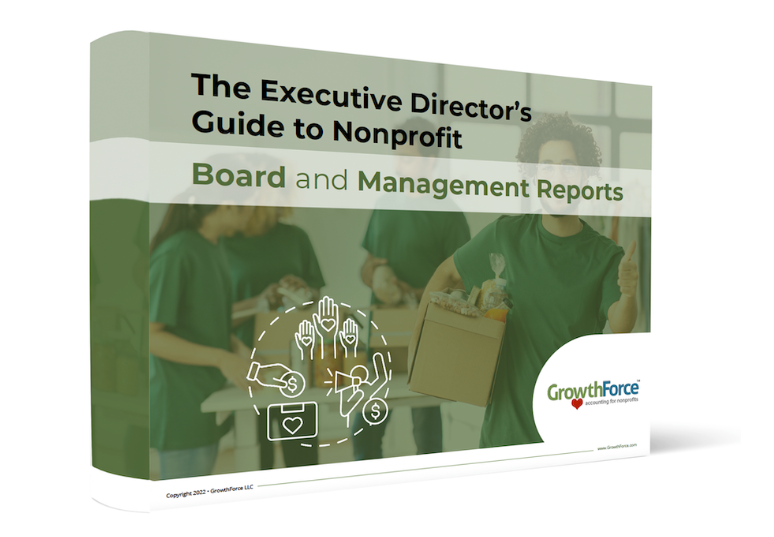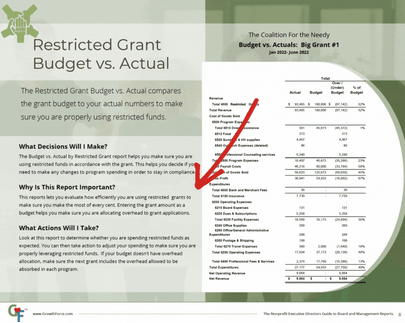6 min read

Financial management and management reporting are not widely understood – not even among for-profit business leaders.
|
Key Takeaways
|
In the nonprofit world, the concept of making data-driven decisions to optimize operations, maximize funds, and trim expenses is often even more of a foreign idea.
As a result, most nonprofit leaders don't realize that they have a wealth of information at their fingertips that can help them grow their organizations and maximize their impact.
All nonprofit leaders need to do is learn how to organize their financial data in a meaningful way and interpret it – and that's where The Nonprofit Report Matrix, The Nonprofit Executive Director's Guide to Board and Management Reports, can open the door to an invaluable wealth of financial and management knowledge.
What Is Nonprofit Reporting and Why Does Your Organization Need It?
If you're running a nonprofit, then you already know that the purpose of some of your NPO reporting is compliance. You're required to generate a nonprofit annual report (Form 990) each tax year. Additionally, your grants and other major funding sources likely also require a certain amount of reporting to track how you are using the funds.
These reporting purposes, however, are just the tip of the iceberg, and if they're the only reasons you're keeping records and tracking financial reports, then you're missing out on major insights into the inner workings of your nonprofit and opportunities to grow your organization.
The primary reason why you should be looking at your financials is for nonprofit management, strategy, and leadership. There are a plethora of financially-based nonprofit organization reports that can help you manage the nonprofit (management reports) and help your board of directors make strategic decisions on behalf of the organization (board reports).
At a Glance: The 8 Best Nonprofit Reports and How to Use Them in Your Organization
1. Organizational Scorecard
Your organizational scorecard, provided by your nonprofit's GrowthForce team, includes gross revenue, gross profit, and EBIDTA charts over a 12-month period and in trailing-12-month (TTM) form.
These six charts analyze some of the most important financial data in your nonprofit and help you identify trends in your numbers that could indicate positive growth or concerning slumps.
2. Budget vs. Actual
The budget vs. actual report provides a high-level view of your organization's planned expenses and income compared to its actual expenses and income.
At a glance, this report can reveal any spending issues that might be occurring within the organization and prompt the board of directors to take a closer, more granular look at the organization's individual program budgets.
3.P&L by Program / Department
These reports are like profit and loss statements in a for-profit business, and they use unit economics to determine your profit and loss (and profit margins in addition to countless other useful KPIs) by class.
For example, you can pull profit and loss statements by program, department, event, marketing campaign, employee, and more.
These reports help you identify the strongest and weakest aspects of your organization and also help you determine how to replicate the strongest parts of your nonprofit in underperforming areas.
4. Budget vs. Actual by Program
If you have ever compared running a nonprofit to herding cats (or used any other similar idiom or metaphor), then you could benefit from budget vs. actual by program reports. These reports look at your budgets (planned income and expenses from individual programs) compared to the actual income and expenses generated by individual programs.
This can help you get all of your ducks in a row and really understand which programs are performing well (i.e. generating income or costing less than expected) and identify those that might be holding you back (i.e. costing you more than they make). Additionally, checking in on these reports monthly (or weekly when your schedule's really packed) can help you anticipate budget shortages before they start to generate cash flow problems in your organization.
5. Restricted Grant Budget vs. Actual
Do you know (really know) how efficiently your organization uses restricted funds? Are any of your programs underperforming or in need of more funding? Would your organization be better off if you cut any particular programs?
By carefully tracking your actual use of restricted grant funds against your budget for these funds, you can start to answer these questions and more to improve your use of restricted funds and make the most of the money in your organization.
6. Statement of Financial Position
A statement of financial position is like having a bird's eye view or snapshot of your organization's finances at any given moment. This report is powerful because, at a glance, it can help your board of directors understand the organization's current financial health while helping them make decisions like whether or not you can afford to add new programs, expand your services, or take on more debt. It can also help you figure out whether or not you're financially prepared to cover unexpected expenses.
7. Statement of Cash Flow
Cash flow is essential to the successful operation of every nonprofit. It helps you (and your board of directors) determine how much money is flowing into and out of your nonprofit while also forecasting what your cash flow will look like in the near future. It's essential to keep a close watch on cash flow statements and forecasts so that you'll never run into a cash flow shortage which can interrupt operations by turning payroll into an emergency or forcing you to curtail your services due to unexpected or poorly timed costs.
Support When You Need It Most: Nonprofit Accounting and Financial Reporting Through Outsourcing
To learn more about nonprofit reporting and leveraging your numbers to improve your nonprofit leadership, download our free ebook. In The Nonprofit Executive Director's Guide to Board and Management Reports, we take a deep dive into the most important financial reports for nonprofit management and strategic leadership.
If your nonprofit's back office is not yet set up to track and record the data necessary to generate these kinds of financial reports, then you are in need of support. At GrowthForce, our bookkeeping and accounting professionals are highly experienced in working with organizations in the nonprofit sector. We can help you bolster your back office and take your financial management skills to the next level. Teamed up with an outsourced accounting team at GrowthForce, you can super-charge your nonprofit management skills while driving your organization's growth and maximizing your impact.

.png?width=563&height=144&name=New%20GF%20Logo%20(37).png)



